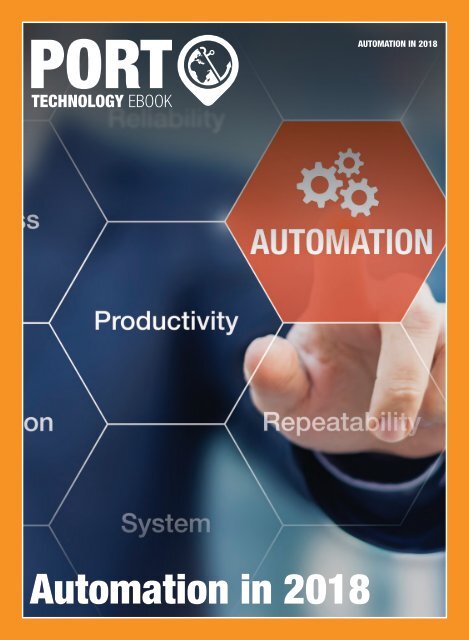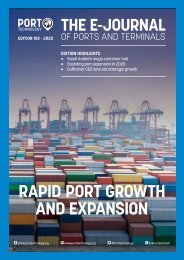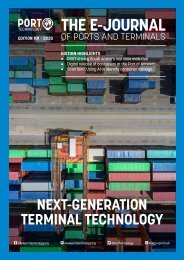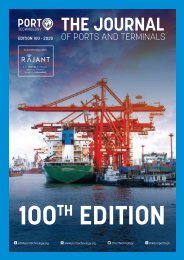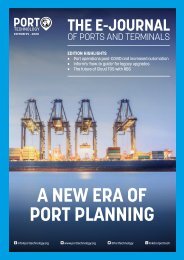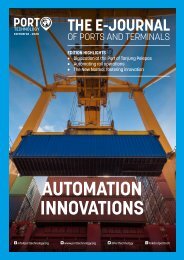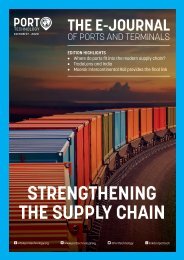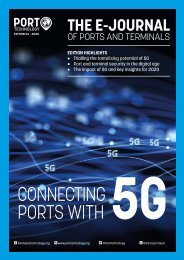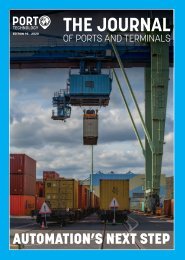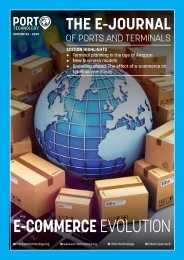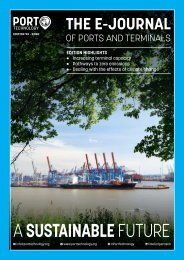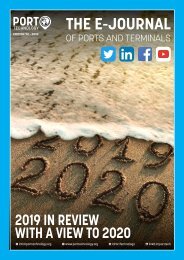AUTOMATION-EJOURNAL-2018-4
e-book features exclusive papers from Cyberlogitec, Containerchain, Motorola and Manzanillo International Terminal
e-book features exclusive papers from Cyberlogitec, Containerchain, Motorola and Manzanillo International Terminal
Create successful ePaper yourself
Turn your PDF publications into a flip-book with our unique Google optimized e-Paper software.
Automation in <strong>2018</strong><br />
<strong>AUTOMATION</strong> IN <strong>2018</strong>
DISCOVER NOW<br />
CONTAINER TERMINAL<br />
<strong>AUTOMATION</strong> CONFERENCE<br />
M2M & AI<br />
6-8 MAY 2019 - LONDON, UK<br />
Container Terminal<br />
Automation Conference<br />
Delivering Performance<br />
6-8 May 2019 - London, UK<br />
#CTAC19<br />
Don’t let technological evolution<br />
outsmart you, attend CTAC19 to<br />
learn more about IoT, M2M and<br />
other intelligent solutions.<br />
“<br />
I FOUND IT REFRESHING TO HAVE TECH SUPPLIERS TOGETHER IN ONE<br />
ROOM, SHARING IDEAS WITH EACH OTHER AND CLIENTS. THEIR REQUEST FOR<br />
STANDARDS AND COOPERATION WAS REMARKABLE!<br />
PAUL VAN BENNEKOM, ECT<br />
“<br />
#CTAC19 X ctac.events X porttechnology.org T @PortTechnology l linkd.in/porttech<br />
B <strong>AUTOMATION</strong> TRENDS - <strong>2018</strong><br />
WWW.PORTTECHNOLOGY.ORG
FROM THE<br />
EDITOR<br />
This is the final publication Port Technology will release in<br />
<strong>2018</strong>, and it marks a highly productive year for us. We’ve<br />
had two successful conferences (CTAC and SPSCT) and 4 well<br />
received editions. Each of the aforementioned has involved<br />
automation in some capacity, and this ebook functions as an<br />
overview of the key conversations and developments in <strong>2018</strong>.<br />
Our first paper herein is from CyberLogitec, who have<br />
provided a paper that looks into smart operations in the<br />
contemporary port environment. This being probably the<br />
biggest trend of <strong>2018</strong>.<br />
The second paper is from Containerchain and looks into<br />
another key contemporary issue – connectivity. This is very<br />
much the future of the industry, with data sharing amongst<br />
ports, shippers and the wider supply chain the seedbed upon<br />
which future operations are based.<br />
Thirdly, we have a Q&A with Motorola. Motorola are<br />
providing a highly interesting offering to the industry in the<br />
form of new communications capabilities, and the insight<br />
provided in the Q&A shows how new players are entering and<br />
changing the sector.<br />
Finally, we have a paper from Tideworks and the Manzanillo<br />
International Terminal in Panama. This completes the ebook<br />
by looking into real world operations in a key strategic<br />
terminal.<br />
Collectively, this ebook offers you an end of year review<br />
of the key trends in <strong>2018</strong>. However, as we prepare for 2019,<br />
this type of publication is something that will be much more<br />
common, as we strive to have a much greater offering in the<br />
form of e-Journals.<br />
Next year we plan to have 10 e-Journals, and 2 print<br />
editions, meaning we’ll effectively have a total of 12 editions<br />
during the calendar year.<br />
Before this begins, please enjoy this final publication of<br />
<strong>2018</strong> from us, and I wish you all a merry Christmas and a very<br />
happy new year.<br />
Richard Joy<br />
Editor<br />
8 jkhan@porttechnology.org X www.porttechnology.org<br />
T @PortTechnology<br />
l linkd.in/porttech<br />
<strong>AUTOMATION</strong> TRENDS - <strong>2018</strong> 1
SMART IS<br />
THE NEW SMALL<br />
Jake Jung-Taek Kim, Cyberlogitec, South Korea<br />
Digital transformation has been bringing<br />
sweeping changes across all industries.<br />
In shipping, the evolution has been<br />
progressive but slow. Ironic for an industry<br />
that has a key role in almost every industry<br />
in the global marketplace today. According<br />
to the International Maritime Organization<br />
(IMO), over 90% of the world’s trade<br />
is carried by sea. But the reality is the<br />
shipping industry has been experiencing<br />
the drag of slow growth hampered by<br />
great operational complexities, stiff<br />
competition, evolving cross-border<br />
challenges and shrinking margins.<br />
Overcapacity and uncertainty in the<br />
global economic and political climate have<br />
been keeping freight rates depressed,<br />
while rising oil prices, vessel charter and<br />
operational costs add pressure on shipping<br />
lines to run a tighter ship. In order to move<br />
more, and move faster, carriers have been<br />
trending towards bigger vessels that can<br />
carry bigger cargo volumes to achieve higher<br />
economies of scale. These mega ships need<br />
larger ports with the capacity, equipment<br />
and technologies that can support the most<br />
efficient vessel turnaround times.<br />
With the bigger ports caught in the<br />
snarl of handling ultra-size vessels along<br />
increasingly congested trade routes,<br />
the initiated small and midsized ports<br />
are already readying themselves for the<br />
cascade of large vessels redeployed their<br />
way. Investments in infrastructure along<br />
with the right smart port technologies,<br />
processes and partners will give smaller<br />
players big advantages. In addition to<br />
more power to lure some vessel traffic<br />
from rival ports, smaller smart ports gain<br />
the agility to ride high on the wave of the<br />
shipping world’s new normal.<br />
FIRST MOVER ADVANTAGE<br />
Indonesia Port Corporation’s (IPC) Pelindo<br />
II, for one, has been playing it smart<br />
for a while now. The Indonesian stateowned<br />
enterprise has been undergoing<br />
vast transformation in recent years with<br />
ongoing improvements by way of hard and<br />
soft infrastructure.<br />
When IPC kick started plans to<br />
implement a new Terminal Operating<br />
System (TOS) for all the terminals under<br />
its operation, it selected TOS provider<br />
CyberLogitec to realize its I.T. and TOS<br />
system implementation investment. From<br />
grooming talents and adopting information<br />
and communications technologies, to<br />
adding new equipment, facilities and<br />
ports, Pelindo II recorded achievements of<br />
sizeable growth in revenue and container<br />
traffic within a short timeframe.<br />
DOING BIG THINGS<br />
A lower cost base, agility and adaptability<br />
to change are key reasons midsized ports<br />
are making relatively swifter migration to<br />
smart port technologies. These intelligent<br />
digital solutions are helping growing ports<br />
to connect man, machines and methods<br />
all along the value chain to uncover<br />
new value and differentiated growth<br />
opportunities that set them apart from<br />
the big boys.<br />
Linking all lines of communications<br />
together, every aspect of the logistics<br />
chain can be managed and controlled<br />
from vessel to gate. Incorporating<br />
integrated intelligence, big-thinking<br />
ports can deploy Internet of Things (IoT)<br />
technology onto their infrastructure<br />
2 <strong>AUTOMATION</strong> TRENDS - <strong>2018</strong> WWW.PORTTECHNOLOGY.ORG
and equipment to enable resources and<br />
processes to interact and exchange ‘live’<br />
data, empowering higher performance<br />
from the day-to-day operations to the<br />
highest level of strategic management.<br />
With vital port logistics processes tracked<br />
in real time, smaller ports can gain<br />
even more agility, optimizing resources<br />
while reducing errors and unplanned<br />
disruptions.<br />
Another significant trend in favor of<br />
smaller players is the rise of smart port<br />
solutions tuned to their needs. Most<br />
TOS solutions are primarily designed for<br />
container handling ports. Yet, many small<br />
and midsized terminals operate with both<br />
containerized and general cargo handling.<br />
With more and more carriers starting or<br />
expanding their multipurpose services,<br />
we are seeing a comeback trend of break<br />
bulk cargo, which is proving to be a fastgrowing<br />
forte for small and midsized ports<br />
to meet this change of tides.<br />
TURNING TO THE CLOUD<br />
Conventional TOS solutions are<br />
implemented on-premise and require<br />
ports to carry the burden of investment on<br />
the IT infrastructure and equipment, and<br />
to retain a team of IT resources to manage<br />
and maintain them, needing to constantly<br />
keep the IT equipment up-to-date and<br />
worry about infrastructure security. This<br />
creates a high initial capital investment<br />
and high recurring IT costs.<br />
But forward-thinking ports are smart.<br />
They know big change can start small.<br />
Whether is it to begin by automating a<br />
particular section of yard processes, or<br />
connecting a pool of people who used<br />
to work in isolation, complexities can be<br />
reduced and efficiencies gained along with<br />
new opportunities for optimization and,<br />
yes, innovation.<br />
Small ports also know that if there’s a<br />
will, there’s a way. And one of these ways<br />
is a cloud-based solution. Many digital<br />
solutions today are readily available in<br />
subscription-based models. For ports of<br />
every size, cloud-based is synonymous<br />
with lower upfront costs, quicker set up<br />
and deployment centrally from the cloud.<br />
A robust TOS, for one, is an advanced<br />
terminal operating system for small<br />
and midsized container terminals with<br />
the capability of handling other cargo<br />
types. The system gives smaller players<br />
the capabilities afforded to their larger<br />
counterparts, yet it makes good sense for<br />
the ‘big boys’ as well.<br />
A NEW BUSINESS CASE<br />
With the right solutions, port operators<br />
can automate and centralize standard<br />
operation procedure management and<br />
optimize business processes in a way that<br />
maximizes productivity and profitability.<br />
Inbuilt intelligent algorithms help<br />
operations personnel plan, schedule,<br />
and forecast operational requirements<br />
of vessels, yard and container handling<br />
equipment in a smart and optimized<br />
way. Data updates are synchronized in<br />
real time on all devices to assist the<br />
operation of job activities, especially<br />
when exceptions arise.<br />
Using SmartLink EDI as an illustration,<br />
digitalized documentation can be linked<br />
to logistics partner systems so that there<br />
is clear visibility of business data across<br />
all links of the supply chain. The terminal<br />
can engage in electronic exchange of<br />
information with multiple industry<br />
organizations, including customs and<br />
port authorities, terminals and shipping<br />
lines, facilitating more efficient and<br />
transparent handling of complicated<br />
issues. Efficiency is upped, mistakes are<br />
reduced and costly downtime avoided.<br />
The terminal becomes better able to<br />
scale up volume without too much<br />
additional investment in workforce and<br />
equipment strength.<br />
A multipurpose TOS is capable of<br />
handling all types of cargo from cars to<br />
containers and bulk commodities and has<br />
scalability to manage multiple terminals in<br />
a single configuration. Fully customizable,<br />
configurable and adaptable to the dynamic<br />
ABOUT THE AUTHOR<br />
Jake Jung-Taek Kim is a sales manager of<br />
maritime and port software technologies<br />
in CyberLogitec Global. With more<br />
than 17 years in the industry, his career<br />
portfolio gave him a strong foundation in<br />
understanding key aspects of the business<br />
operations. He is currently responsible<br />
for business development, global account<br />
management, software product selling,<br />
and developing strategic alliances within<br />
South East Asia.<br />
Jake began his career as a system engineer.<br />
He went on to managing enterprise<br />
infra system operations, designing<br />
system architecture, implementing<br />
new technologies and leading various<br />
IT projects within CyberLogitec. He<br />
developed strong business acumen<br />
harnessing on strategic partnerships and<br />
key market analysis that contributed to<br />
the growth for the company. Jake helmed<br />
the role as Project Lead for various TOS<br />
(Terminal Operating System) projects<br />
in Korea, Indonesia, Spain and other<br />
countries, delivering clear business<br />
benefits for clients.<br />
needs of each terminal, the system<br />
ensures all aspects of operations can be<br />
managed in real-time while keeping track<br />
of all cargo movements.<br />
Entirely HTML5-based, and operable<br />
on all devices, the solution enables<br />
users to access the applications anytime,<br />
anywhere even on their mobile devices as<br />
long as there is internet connectivity. From<br />
a single-window view with highly intuitive<br />
user interface comprising of rich graphics,<br />
yard operators can easily zoom in and out<br />
of the yard with full 3D visibility including<br />
ability to view into in-between container<br />
stacks.<br />
Moving seamlessly from screen to<br />
screen, users enjoy information at their<br />
fingertips that aids close monitoring of<br />
yard operations. Built to be highly adaptive<br />
to change, CyberLogitec’s latest innovation<br />
is scalable to accommodate the growing<br />
demands of progressive ports.<br />
SUMMARY<br />
In the long run, container traffic is<br />
projected to be on the rise particularly<br />
in the emerging economies of the world.<br />
While they cannot physically compete with<br />
large ports in their capabilities to serve<br />
today’s mega vessels, smaller ports can<br />
leverage smart technologies to reinvent<br />
themselves and cruise comfortably into<br />
the new era of shipping.<br />
ABOUT THE ORGANIZATION<br />
CyberLogitec is a global leader in providing<br />
technological innovation for maritime,<br />
terminal and logistics industry. We drive<br />
innovation by leveraging on our extensive<br />
industry knowledge and vast experience<br />
to meet the evolving needs of the market.<br />
We understand that optimizing operations<br />
is important for productivity and service<br />
delivery and we strive to continuously<br />
strengthen our capabilities by seeking<br />
to improve customers’ overall efficiency,<br />
competitiveness and productivity.<br />
CyberLogitec is committed to provide<br />
flexible end-to-end solutions and<br />
business consultation for the maritime,<br />
port and logistics industry. We harness<br />
the strengths of our strategically located<br />
presence in U.S.A, Europe, China,<br />
Singapore and Korea to engage with<br />
our clients and partners to identify key<br />
markets and seize new opportunities.<br />
ENQUIRIES<br />
Email: sales@cyberlogitec.com<br />
Web: www.cyberlogitec.com<br />
<strong>AUTOMATION</strong> TRENDS - <strong>2018</strong> 3
PORT COMMUNITY<br />
CONNECTIVITY<br />
PLATFORMS AND LANDSIDE<br />
Chris Collins, Chief Operating Officer,<br />
Containerchain, Singapore<br />
In my last technical paper in The Journal<br />
of Ports and Terminals on Container<br />
Logistics 4.0, I identified platforms and<br />
data ecosystems as one of the foundational<br />
pillars for digital transformation and new<br />
value creation in logistics and shipping. In<br />
this paper, I take a more focused look at<br />
the evolution of digital platforms across<br />
the container logistics supply chain and the<br />
importance of their connectivity to port,<br />
terminal, and landside logistics operations.<br />
PERSONALIZED DISRUPTION<br />
Over the past few years, tech giants such<br />
as Alibaba, Amazon, Apple, eBay, Facebook<br />
and Google, as well as younger disruptors<br />
like AirBnB and Uber, have graphically<br />
demonstrated the power of platform<br />
technology to connect multiple consumers<br />
and producers via digital applications.<br />
Processing multiple interactions and<br />
transactions at unprecedented scale,<br />
speed, and scope. These major digital<br />
platform economies are continually mining<br />
the vast quantities of data generated to<br />
optimize operations and enable ‘mass<br />
personalization’.<br />
In the B2B space, platforms present a<br />
unique way to conduct business, while they<br />
grow exponentially in size and importance,<br />
providing unparalleled opportunities for<br />
value creation. The World Economic Forum’s<br />
Digital Transformation Initiative predicts<br />
that platform-driven interactions will enable<br />
approximately two-thirds of the US$100<br />
trillion value at stake from digitalization<br />
by 2025. To survive in the new digital<br />
economy, enterprises will either need to<br />
embrace platform connectivity, or risk falling<br />
dramatically behind in the fast-moving push<br />
toward more collaborative supply chain<br />
efficiency.<br />
PORT COMMUNITY SYSTEMS<br />
Ports and landside connected supply<br />
chains are, of course, essentially physical<br />
platforms and ecosystems in themselves.<br />
They are physical nodes where a complex<br />
web of private and government entities<br />
converge to interact and transact the<br />
business of international trade. It comes<br />
as little surprise then that the port sector<br />
was one of the first to develop the concept<br />
of information sharing platforms with<br />
the launch of the first EDI-based port<br />
community systems (PCS) in Europe back in<br />
the late 1970s and early 1980s.<br />
A neutral and open electronic platform<br />
enabling intelligent and secure exchange<br />
of information between public and private<br />
stakeholders to improve the competitive<br />
position of seaport and airport communities,<br />
a PCS typically facilitates both B2G and<br />
B2B transactions, providing a standardized<br />
system to process data related to exports,<br />
imports, transhipments, consolidations,<br />
hazardous cargo and maritime statistics<br />
reporting. In many parts of the world,<br />
regulatory and trade process compliance<br />
is a core function. Increasingly today, PCS<br />
also form part of larger government trade<br />
facilitation, simplification and digitalization<br />
6 <strong>AUTOMATION</strong> TRENDS - <strong>2018</strong> WWW.PORTTECHNOLOGY.ORG
initiatives through ‘Single Window’ and<br />
e-Trade programmes.<br />
Whilst traditionally PCS’s play a key role in<br />
facilitating the flow of cargo and information<br />
through ports, they tend to be limited<br />
in their connectivity with landside and<br />
hinterland ecosystems. Additionally, they too<br />
often focus on promoting the importance of<br />
information capture over providing practical<br />
digital applications that incentivize users<br />
to share information in real-time as part of<br />
solving the operational problems that create<br />
inefficiencies in the supply chain itself.<br />
Practical digital platform applications<br />
that seek to reduce landside congestion<br />
and pollution, optimize facility utilization,<br />
expedite tri-modal traffic flows to, from,<br />
and within port areas, share information<br />
in real-time allowing proactive operational<br />
planning amongst participants (whether it<br />
be shippers, 3PLs, hauliers and other inland<br />
operators such as dry ports) are evolving<br />
rapidly and are all aimed at unlocking trapped<br />
value created by today’s inefficiencies. The<br />
importance for the industry to connect these<br />
often-independent platform applications<br />
to a PCS is a critical evolution required to<br />
deliver the true benefits of digitization to the<br />
container logistics supply chain.<br />
PORTS LEADING THE WAY<br />
Major port centres including Antwerp,<br />
Hamburg, Los Angeles, Long Beach,<br />
Rotterdam, Singapore and others, plus<br />
shipping line and global terminal operators<br />
looking to get more embedded in the supply<br />
chain ‘beyond the gate’, are embarking on<br />
digital initiatives to capture, harvest, pool<br />
and share more data in more collaborative,<br />
real-time ways, with maritime and landside<br />
logistics stakeholders.<br />
The Port of Rotterdam’s CFO recently said<br />
that investing in soft digital infrastructure<br />
is now as important as the physical<br />
infrastructure itself. PSA International, the<br />
operator of the Port of Singapore and an<br />
international network of terminals, has laid<br />
out its vision to work with customers and<br />
partners on improving E2E cargo flow with<br />
new solutions that "exploit the opportunities<br />
which digitalization offers, taking advantage<br />
of the fact that PSA already operates at key<br />
nodes of global trade and supply chains."<br />
Other multinational terminal groups have<br />
also expressed their intent to get closer<br />
to shippers and provide more inland<br />
connectivity, intelligence and value added<br />
digital services.<br />
These enterprise and geographiccentric<br />
initiatives are crucial as is their<br />
connectivity to digital landside logistics<br />
(LL) platforms. Designed to optimize the<br />
movement of containers from port gate to<br />
door and back again, LL platforms connect<br />
the ecosystem of cargo owners, landside<br />
logistics providers and transporters, marine<br />
terminals, shipping lines, inland depots/<br />
ports, and warehouses/DCs.<br />
Singapore has recently provided two<br />
significant examples of this strategic direction<br />
under its National Trade Platform – with<br />
plans to connect over 10,000 of its existing<br />
registered users to a single independent<br />
Transport Integrated Platform (TRIP) that<br />
has already connected a large majority of<br />
the landside containerized supply chain, and<br />
in doing so, delivered significant operational<br />
and economic benefits to its stakeholders.<br />
BEYOND THE PORT<br />
Independent B2B LL platforms offer a<br />
critical path for the myriad of SME players<br />
that make up a significant number of any<br />
inland cargo community – many still with<br />
limited-to-no digital resources – to get<br />
connected to the network and in some<br />
cases, access digital business applications<br />
and processes to improve their day to day<br />
operations via adopting a digital industry<br />
‘baseline’. They also provide the central<br />
‘link and structure’ to connect and enable<br />
emerging technologies such as Internet of<br />
Things (IoT) real-time tracking and sensors,<br />
blockchain / distributed ledgers, analytics,<br />
and artificial intelligence (AI) that can<br />
exponentially improve data quality and<br />
value to the benefit of all the platform<br />
participants.<br />
But to extract maximum mutual value<br />
from the emerging platform economy –<br />
and avoid simply replacing current data<br />
silos and outdated manual processes with<br />
new digital divides – stakeholders, owners<br />
and operators of PCS’s and independent LL<br />
platforms must work out how to collaborate<br />
and communicate on a local, regional and<br />
cross-border basis.<br />
Interoperability via APIs and<br />
standardization of messaging flow are<br />
key, enabling a network made up of a<br />
system of systems to be created. Equally<br />
important are the rules of engagement and<br />
governance within and between different<br />
(and possibly competing) data ecosystems,<br />
as well as between private and publicsector<br />
interests.<br />
KEY TAKEAWAY POINTS<br />
Balancing out platform competition and<br />
collaboration, international and localized<br />
solutions, closed and open offerings and free<br />
market choice against regulatory oversight is<br />
a very difficult challenge, but not one that<br />
can be avoided if we all want to reap the<br />
benefits of digital collaboration.<br />
One thing is certain, the technology is<br />
on hand to address enduring supply chain<br />
stakeholder concerns about fulfilment<br />
inefficiencies, lack of coordination and poor<br />
visibility. But approaching the upcoming<br />
inevitable proliferation of digital platforms<br />
and offerings from an earlier mindset will not<br />
get us to where we want to go. As Einstein<br />
said: "We can't solve problems by using<br />
the same kind of thinking we used when<br />
we created them." Coordinated discourse<br />
between market players and policymakers<br />
is therefore crucial as we enter the next<br />
wave of digital development and application<br />
of technology to drive operational and<br />
economic efficiency across the container<br />
logistics supply chain.<br />
ABOUT THE AUTHOR<br />
Chris Collins is the Chief Operating Officer<br />
of Containerchain, a digital operations<br />
and collaboration platform provider to the<br />
landside container logistics community.<br />
ABOUT THE ORGANIZATION<br />
Dedicated to simplifying operational<br />
processes, improving customer service levels,<br />
and driving down the cost of moving containers<br />
from port-to-door, Containerchain’s platform<br />
and products provide real-time paperless<br />
information exchange, automation of manual<br />
processes, proactive operational planning<br />
tools, total container movement visibility, and<br />
real-time synchronized connectivity across<br />
the supply chain.<br />
ENQUIRIES<br />
Web: www.containerchain.com<br />
<strong>AUTOMATION</strong> TRENDS - <strong>2018</strong> 7
MOTOROLA SOLUTIONS<br />
TIM CLARK<br />
DIRECTOR OF SYSTEMS SALES (EMEA),<br />
MOTOROLA SOLUTIONS, LONDON, UK<br />
A&<br />
1) WHAT CHANGE DO YOU WANT TO BRING<br />
TO THE PORT AND TERMINAL SECTOR?<br />
There are many changes already taking place<br />
in the port and terminal sector: increasing<br />
scale of operations to accommodate megaships;<br />
consolidation in the shipping market;<br />
formation of mega-alliances; increasing<br />
frequency of extreme weather events;<br />
growing threat of physical and cybersecurity<br />
attacks. All of these changes are<br />
generating serious challenges for ports and<br />
terminals.<br />
Motorola Solutions is changing the<br />
way port and terminal organisations<br />
communicate and run their operations to<br />
increase efficiency, safety and security. Our<br />
mission-critical communications solutions<br />
are giving our port and terminal sector<br />
customers the competitive edge to succeed<br />
in challenging times.<br />
To remain competitive, ports and<br />
terminals are streamlining their operations<br />
and automating processes – immediate,<br />
ubiquitous and dependable communication<br />
between people and smart machines is<br />
more important than ever.<br />
Workers are operating in increasingly<br />
remote and hazardous environments<br />
amongst massive structures, mobile<br />
machinery and vehicles. Instant<br />
communication and automated real-time<br />
monitoring provides a critical lifeline for<br />
mobile workers and ensures they have the<br />
information they need to get the job done<br />
fast.<br />
Different workgroups and organisations<br />
operating within the port must be able to<br />
communicate seamlessly and merge their<br />
business processes to avoid bottlenecks and<br />
mistakes which will cause delays and reduce<br />
margins.<br />
Unfortunately security protection is<br />
an ever-increasing challenge – port and<br />
terminal operators must keep one step<br />
ahead of sophisticated criminal gangs and<br />
terrorists who consider ports as targets.<br />
Being able to identify potential hazards<br />
and reacting to prevent attacks is a key goal<br />
for port security teams, as is controlling<br />
access without slowing the flow of cargoes<br />
in and out of the terminal. Cyber attacks in<br />
the form of “ransomware” are becoming<br />
more frequent and there have been welldocumented<br />
incidents in recent years which<br />
have crippled operations and incurred huge<br />
costs for organisations worldwide.<br />
In short, there are many new challenges<br />
for port and terminal operators – our<br />
solutions are changing communication<br />
and operations to help overcome these<br />
challenges and ensure successful and<br />
profitable businesses.<br />
2) HOW ARE YOU GOING TO IMPLEMENT<br />
THAT CHANGE?<br />
The Motorola Solutions portfolio of marketleading<br />
mission-critical communication<br />
products and services is enabling port and<br />
terminal operators to increase the efficiency,<br />
safety and security of their workforce and<br />
business processes. Motorola Solutions<br />
serves more than 100,000 public safety<br />
and commercial customers in more than<br />
100 countries - our customers rely on us<br />
for the expertise, services and solutions we<br />
provide, trusting our years of invention and<br />
innovation experience. By partnering with<br />
customers and observing how our products<br />
can help in their specific industries, we are<br />
able to enhance our customers’ experience<br />
every day.<br />
Motorola Solutions is the global market<br />
leader in two-way radio technology. Our<br />
DIMETRA, ASTRO® 25 and MOTOTRBO<br />
portfolios provide ports and terminals with<br />
tailored, reliable and robust voice and data<br />
communications to ensure that mobile<br />
workers stay connected even in the worstcase<br />
scenario. Two-way radio has significant<br />
benefits over alternative technologies:<br />
instant group communications; system<br />
coverage designed for each port; rugged,<br />
purpose-built devices; redundancy with<br />
automated switch-over to mitigate risk of<br />
downtime.<br />
Our wide range of control room solutions<br />
ensures port operations are efficient and<br />
safe. Incidents can be resolved quickly<br />
and investigations conducted efficiently to<br />
help prevent future problems. Automated<br />
tracking of workers, vehicles and machinery<br />
across the terminal helps to ensure efficient<br />
use of resources and reduces costs.<br />
Automation is becoming more important<br />
to port and terminal operators who are<br />
constantly looking to minimise costs and<br />
speed up processes - the Industrial Internet<br />
of Things (IIoT) portfolio from Motorola<br />
Solutions enables connectivity between<br />
control rooms and sensors and switches to<br />
monitor and control remote infrastructure<br />
and equipment such as sirens, gates and<br />
port access security systems.<br />
The Avigilon portfolio of intelligent<br />
cameras, video analytic solutions and<br />
access control products provides stronger<br />
protection against security attacks through<br />
smart access control and incident prediction<br />
and monitoring. Facial recognition<br />
technology and Automatic Licence Plate<br />
8 <strong>AUTOMATION</strong> TRENDS - <strong>2018</strong> WWW.PORTTECHNOLOGY.ORG
MOTOROLA SOLUTIONS<br />
Recognition (ALPR) identify and track people<br />
and vehicles without impacting flow rate<br />
through gates. A network of fixed cameras<br />
can be augmented with body-worn cameras<br />
on port security staff to provide real-time,<br />
ubiquitous monitoring.<br />
Motorola Solutions also has a<br />
comprehensive range of cyber protection<br />
products and services to protect ports<br />
against the growing threat of malware.<br />
3) HOW DO YOU THINK COLLABORATION<br />
CAN BE INCREASED ACROSS THE SUPPLY<br />
CHAIN?<br />
In short, effective collaboration is dependent<br />
upon seamless voice and data transfer – and<br />
that’s what mission-critical communications<br />
delivers. Focussing in on the role that ports<br />
and terminals play within the supply chain,<br />
there are many different organisations<br />
which need to stay fully informed to ensure<br />
efficient operations; port management,<br />
shipping companies, freight operators,<br />
emergency services, utlilities providers, etc.<br />
Typically each organisation uses different<br />
communication systems – presenting<br />
a challenge to seamless transfer of<br />
information. The Motorola Solutions WAVE<br />
portfolio of broadband workgroup solutions<br />
operates over multiple technologies - twoway<br />
radio, Wi-Fi, 3G/4G, telephony and<br />
more - and can be used to bridge different<br />
systems. For example, onsite two-way radio<br />
users can communicate with colleagues and<br />
partners who have WAVE applications on<br />
their smartphones – both onsite and offsite.<br />
WAVE effectively extends the benefits<br />
of group communication traditionally<br />
associated with two-way radio: instant<br />
voice communications at the touch of a<br />
button; all-informed workgroups who have<br />
the real-time information they need to get<br />
the task completed quickly and safely; fullyintegrated<br />
essential data services such as<br />
text messaging, location tracking, work<br />
ticketing and status updates.<br />
For many of our customers, two-way radio<br />
was selected as the optimal communication<br />
technology because of the high level of<br />
security and robustness it provides. The use<br />
of WAVE in conjunction with a two-way radio<br />
system does not compromise security – the<br />
protection provided by WAVE is designed<br />
to meet the stringent information security<br />
requirements of government agencies.<br />
Motorola Solutions connects people<br />
through technology. Public safety and<br />
commercial customers around the world<br />
turn to Motorola Solutions innovations when<br />
they want highly connected teams that have<br />
the information they need throughout their<br />
workdays and in the moments that matter<br />
most to them.<br />
4) WHAT DO YOU PREDICT FOR THE SUPPLY<br />
CHAIN COMMUNICATION IN 10 YEARS’<br />
TIME?<br />
Industry analysts expect automation to be<br />
implemented throughout the supply chain<br />
in coming years: virtual customer assistants<br />
and chatbots will interact with customers;<br />
unmanned mobile robots will replace<br />
warehouse workers in forklifts; drones and<br />
autonomous trucks and ships will transport<br />
cargo; autonomous cranes and loaders will<br />
speed up port operations.<br />
Internet of Things (IOT) technology will<br />
create a fully-integrated supply chain, from<br />
end to end.<br />
Artificial Intelligence (AI) and smart<br />
analytics of Big Data will enable predictive<br />
logistics, where goods are sent through the<br />
supply chain ahead of demand.<br />
The implementation of the Blockchain<br />
peer-to-peer ledger model will enable smart<br />
commerce and streamline the entire supply<br />
chain. Implementation of Blockchain will<br />
not be immediate but the impact will be<br />
profound.<br />
In summary, there is unprecedented<br />
change underway in the supply chain and<br />
the rate of change is expected to increase<br />
into the future.<br />
Mission-critical communication will be a<br />
key enabler of change in the supply chain<br />
and in ports and terminals in particular<br />
– connecting physically isolated workers<br />
with immediate voice and essential data<br />
services will become more challenging but<br />
increasingly important.<br />
Robust voice and data communication<br />
networks which have been designed<br />
specifically for individual ports, to keep<br />
people and smart machines connected in<br />
the most extreme events, will be critical.<br />
Motorola Solutions is constantly<br />
innovating mission-critical communications<br />
to stay ahead of our customers’ requirement.<br />
Taking great ideas from concept to reality is<br />
what innovative companies do. At Motorola<br />
Solutions, we believe true innovation occurs<br />
when a new technology solves a problem<br />
customers didn't know they had or in a<br />
way they never thought possible. We strive<br />
to deliver solutions that bring the right<br />
information, to the right person, at the right<br />
time. For example, our pioneering work in<br />
the field of High Velocity Human Factors,<br />
an area of cognitive research, informs<br />
our approach to design. We develop<br />
products for first responders by working<br />
with them in crisis situations to study their<br />
communication needs. We take what we<br />
learn in the field and bring it back to the<br />
lab to create products that will function<br />
under extreme conditions and networks<br />
that will reliably support those products.<br />
With unparalleled domain and design<br />
expertise, we anticipate industry shifts,<br />
recognize market disruptors and develop<br />
breakthrough technology solutions using a<br />
proven framework that helps transform the<br />
industries we serve.<br />
5) WHAT IS THE ROLE OF THE HUMAN IN<br />
THE DIGITAL SUPPLY CHAIN?<br />
Technology in the form of automation,<br />
Artificial Intelligence, the Internet of<br />
Things and Blockchain will streamline<br />
the supply chain and remove the human<br />
element from repetitive and manual tasks.<br />
However, people will continue to play key<br />
roles in efficient, safe and secure ports and<br />
terminals.<br />
The management of port and terminal<br />
operations will be assisted and augmented<br />
with data analytics and artificial intelligence<br />
but critical decision making will rely on<br />
humans. Also, incident management -<br />
informed, immediate response to minimise<br />
the impact of failures, attacks or natural<br />
disasters – will depend upon highly-skilled<br />
staff with the best information and tools.<br />
Motorola Solutions is investing in smart<br />
video and data capture and analytics to<br />
provide response teams with concise,<br />
relevant, actionable information. Forwardlooking<br />
solutions such as our Avigilon<br />
cameras and video analytics portfolio<br />
and the Command Centre Software suite<br />
will increase situational awareness and<br />
accelerate decision-making for ports<br />
operational staff.<br />
To further enhance the richness of data<br />
available to incident response teams, port<br />
workers will be equipped with wearable<br />
devices – cameras, sensors, location<br />
trackers, smart user interfaces – which will<br />
continually monitor, assess and report the<br />
operating environment to ensure workers<br />
have comprehensive, timely and relevant<br />
information to hand when they need it.<br />
ENQUIRIES<br />
www.motorolasolutions.com<br />
presales.info@motorolasolutions.com<br />
+44 207 019 0461<br />
<strong>AUTOMATION</strong> TRENDS - <strong>2018</strong> 9
MANZANILLO<br />
INTERNATIONAL TERMINAL<br />
A 360-DEGREE TERMINAL VIEW<br />
Thomas J. Rucker, President of Tideworks Technology, USA<br />
Whereas international cargo tends to<br />
grow linearly, data generated with the<br />
movement of goods grows exponentially,<br />
thereby driving a profound need for port<br />
and terminal operators to add visibility into<br />
their enterprise data, and more importantly,<br />
to make that data actionable.<br />
Real-time data access and visibility has<br />
increasingly become a top priority for the<br />
shipping and logistics industry. A global<br />
survey from the Business Performance<br />
Innovation (BPI) network of more than 200<br />
executives found that the biggest challenges<br />
facing the ocean supply chain included<br />
poor coordination between partners<br />
(57 percent), too little transparency and<br />
visibility (50 percent) and inefficiencies with<br />
the supply chain (37 percent).<br />
Survey respondents then noted the areas<br />
most in need of process improvement to<br />
be carrier-to-terminal coordination and<br />
planning (35 percent), supply chain visibility<br />
and information sharing (35 percent),<br />
terminal operations (24 percent), cargo<br />
flow visibility and predictability (24 percent)<br />
and coordination across carrier and shipper<br />
alliances (24 percent).<br />
One terminal that has recognized<br />
the connection between data visibility<br />
and improved operations is Panama’s<br />
Manzanillo International Terminal (MIT).<br />
One the largest and most important<br />
terminals in Central America, MIT provides<br />
connections to 129 ports in 48 countries.<br />
The facility offers efficient and reliable<br />
port services 24 hours a day, seven days a<br />
week to the many shipping lines serving the<br />
region.<br />
MIT<br />
MIT started its journey towards data<br />
discovery back in 2012 when it developed<br />
its own data warehouse and business<br />
intelligence (BI) solution in order to<br />
store operational data from its terminal<br />
operating system (TOS). While “home<br />
grown” solutions can be adequate in<br />
smaller deployments, for a terminal the<br />
size of MIT, the challenges quickly became<br />
evident. For example:<br />
• The team was unable to integrate data<br />
from other systems into the database as<br />
needed<br />
• System performance was significantly<br />
impacted, especially when users tried<br />
to extract data from the TOS, generate<br />
complex reports, or perform demanding<br />
queries against the production system<br />
The MIT team prioritized several criteria<br />
in outlining their future vision, specifying<br />
several key requirements that provide a<br />
handy baseline for any terminal looking to<br />
automate. These requirements were:<br />
• The ability to provide a complete,<br />
360-degree view of terminal operations<br />
• The ability to seamlessly connect<br />
external systems<br />
• The ability to quickly and easily access,<br />
filter and drill down to vital operational<br />
and enterprise metrics<br />
• The ability to gain insight from<br />
enterprise data in order to make realtime<br />
performance decisions<br />
• Functionality that would not drain or<br />
degrade system performance<br />
10 <strong>AUTOMATION</strong> TRENDS - <strong>2018</strong> WWW.PORTTECHNOLOGY.ORG
In MIT’s case, theoretical desires quickly<br />
bumped up against real-world availability.<br />
The terminal found that off-the-shelf<br />
solutions were largely unable to meet its<br />
extremely specialized and precise needs,<br />
nor could they provide the necessary levels<br />
of customer support and customization.<br />
MIT stated they needed rapid<br />
functionality without a negative impact on<br />
system performance, while also needing<br />
to be able to draw in data from external<br />
sources as native SQL and then integrate<br />
those with their own data. Ultimately, they<br />
needed to position the terminal to meet<br />
the evolving needs of our customers, which<br />
required a flexible, adaptable solution.<br />
A PLAN OF ACTION<br />
In order to fix the solution, MIT assiduously<br />
monitored its performance, data integration<br />
and data accuracy. The team also built and<br />
tested specific metrics around automatic<br />
stacking crane (ASC) productivity based<br />
on MIT’s feedback, with additional metrics<br />
continuously being added.<br />
It was important for MIT to fine-tune<br />
the solution for users so they could utilize<br />
the platform to organize key performance<br />
indicators (KPIs) into a single, self-service<br />
dashboard. The beta testing (and eventual<br />
deployment) allowed users to add new<br />
metrics without significantly changing<br />
existing data models, while also storing<br />
years’ worth of historical information for<br />
executive-level analysis and planning.<br />
The benefits of deploying a data platform<br />
are manifold for terminal operators like<br />
MIT. The solution allowed them to evaluate<br />
existing reports, determine their value, and<br />
create a new reporting structure. They were<br />
also able to eliminate some duplicative<br />
reports and create new ones that produced<br />
far more relevant and powerful results.<br />
RESULTS<br />
A key factor that led to the successful<br />
widespread deployment of the solution<br />
was the intuitive interface. As MIT users<br />
became more familiar with the platform,<br />
even non-technical terminal employees<br />
were able to quickly create reports without<br />
having to rely on specialized IT personnel,<br />
leading to more efficient workflows and<br />
increased productivity.<br />
Operational efficiencies also improved<br />
with the rollout, allowing MIT to do more<br />
with existing resources and scale its<br />
operations. This wholly-integrated solution<br />
gave MIT the 360-degree operational<br />
visibility it sought, while providing the<br />
ability to integrate information from ERP or<br />
other non-TOS related systems, as well as a<br />
means to visualize and analyze data on an<br />
enterprise-wide level.<br />
Being able to identify patterns and<br />
outliers allowed MIT to quickly improve<br />
operations and reduce its costs. As an<br />
example, the terminal was using Excel<br />
with macros to run a yard density report.<br />
Now it has a dashboard that automatically<br />
populates, significantly reducing the time<br />
and effort to obtain this information.<br />
Instances such as this have shown me the<br />
following key questions when looking into a<br />
terminal operating system:<br />
• Does the solution provide a complete,<br />
holistic view of port operations?<br />
• Am I able to gain visibility to operational<br />
and business data that is both reliable<br />
and actionable?<br />
• How will the solution impact system<br />
performance? Can my team access<br />
valuable KPIs, perform data analytics and<br />
create reports without the performance<br />
of the production system being degraded?<br />
• How well does the solution integrate<br />
enterprise data from other business<br />
systems?<br />
ABOUT THE AUTHOR<br />
Thomas J. Rucker joined Carrix in 1999<br />
as a project manager within the Y2K<br />
project team. Shortly after Tideworks was<br />
formed, he relocated to Panama where<br />
he oversaw IT Operations throughout<br />
Central and South America. Thomas then<br />
relocated back to Seattle and held the<br />
position of Vice President of Product and<br />
Professional Services. He was responsible<br />
for the innovation and execution of a<br />
variety of terminal operating system<br />
solutions at marine and rail facilities<br />
around the globe. Most recently, Thomas<br />
served as the Vice President of Operations<br />
for Manzanillo International Terminal<br />
(MIT) providing strategic and tactical<br />
leadership for the company’s operational<br />
functions.<br />
ABOUT THE ORGANIZATION<br />
Tideworks is a full-service provider of<br />
cost-effective, reliable software solutions<br />
for growing terminal operations and<br />
shipping lines worldwide. The company<br />
helps more than 65,000 users at 100<br />
facilities run their operations more<br />
efficiently and profitably. From optimized<br />
equipment utilization to faster turn times,<br />
Tideworks works at every step of terminal<br />
operations to maximize productivity and<br />
customer service.<br />
ENQUIRIES<br />
www.tideworks.com.<br />
<strong>AUTOMATION</strong> TRENDS - <strong>2018</strong> 11
#CTAC19<br />
Container Terminal<br />
Automation Conference<br />
Delivering Performance<br />
6-8 May 2019 - London, UK<br />
Don’t let technological evolution<br />
outsmart you, attend CTAC19 to learn<br />
more about IoT, M2M and other<br />
intelligent solutions.<br />
DISCOVER NOW<br />
#CTAC19 X ctac.events X porttechnology.org T @PortTechnology l linkd.in/porttech
“<br />
I FOUND IT REFRESHING TO HAVE<br />
TECH SUPPLIERS TOGETHER IN ONE<br />
ROOM, SHARING IDEAS WITH EACH<br />
OTHER AND CLIENTS. THEIR REQUEST<br />
FOR STANDARDS AND COOPERATION<br />
WAS REMARKABLE!<br />
“<br />
CONTAINER TERMINAL<br />
<strong>AUTOMATION</strong> CONFERENCE<br />
M2M & AI<br />
6-8 MAY 2019 - LONDON, UK<br />
PAUL VAN BENNEKOM, ECT<br />
“<br />
A MEETING OF MINDS ON HOW<br />
OUR INDUSTRY CAN ADVANCE<br />
OURSELVES THROUGH BETTER<br />
UNDERSTANDING AND HARNESSING<br />
OF <strong>AUTOMATION</strong>.<br />
“<br />
ADRIAN SIM, ASSISTANT VICE PRESIDENT, PSA<br />
CORPORATION LTD<br />
“<br />
THE CONFERENCE SPEAKERS ALL<br />
HAVE EXTENSIVE EXPERIENCE IN<br />
THE SUBJECT MATTER, IT’S THAT YOU<br />
MANAGE TO BRING TOGETHER SO<br />
MANY EXPERTS.<br />
“<br />
RICH CECI, PORT OF VIRGINIA


